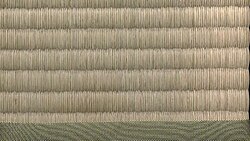Tatami

Tatami (畳 tatami) mats are a traditional Japanese flooring. The top surface is made of woven straw. Traditional tatami are packed with straw. Nowadays some of them are packed with styrofoam. Tatami are individual mats. They have a uniform size and shape. They have borders of brocade or plain green cloth.
Tatami were originally a luxury item for the rich at a time when lower classes had mat-covered dirt floors.[1] Tatami were gradually popularized. They finally reached the homes of commoners towards the end of the 17th century.[2]
History
Japanese people have used tatami since the Nara Era (710-794). They were knitted and became thicker like modern tatami. People who lived in the Heian Era stepped onto tatami to show their power and they spread the tatami only in a necessary part of the room.
The use of tatami was a little different from now. The shoin style of traditional Japanese residential architecture began in the Kamakura Era. During this time, people stopped spreading tatami around the room and placing them in the middle. They started to spread tatami through the room. People decided to spread tatami by the hearth and sit erect with their legs folded under.
Tatami has been changing together with people's life style. Tatami became common for people in the middle of the Edo Era. Farmers started to use them in the Meiji Era. The removal of tatami regulation made them more common in the Meiji Era. Japanese people often dry the tatami. If the tatami's surface was discolored, people often turned them over. With the economic growth after World War Two people started to use chairs and carpets. Japanese people think flooring is not relaxing or soundproof enough, so people still use tatami now.
Making Tatami
Tatami is made with a rush plant, igusa. Rush is planted in the rice fields in August. The seedlings are dug out in November, and a good seedling is chosen. The chosen seedlings are planted in the rice fields again in December. By the end of June to the middle of July, the high-quality rush grows up to about one meter tall and it will be harvested the next year.
The rush should be dry after harvesting, and keep the peculiar smell and the color of the rush. The rush is selected according to length and the thickness, and it is checked for bruising.
After the harvest ends, tatami is made. Because Japanese rooms are different sizes, tatami are made in different sizes. The base of the tatami is made first. Tatami is woven with a special machine. It similar to the weaving on a kimono. The next part is the wick of tatami, called toko. When the toko is 40 centimeters or more thick, and the shape is straightened. The mat is complete, and that is called mushiro. The tatami is complete when it is joined to the toko and the decoration on the mat edges are sewn.
Igusa
Igusa is a perennial plant of the family of igusa. Igusa smells good. It has a fresh, grassy smell. In English, they are called rushes. Igusa blooms from May through June. The plant grows up to a length of 100 centimeters or less. They grow in marshes where sunshine is good. In Japan, there are 30 kinds of igusa growing in many different areas.
Tatami is made from natural igusa that must be flexible from the root to the tip, and the thickness and the color varies slightly. About 4000 to 7000 igusa are used for the tatami. Generally the best tatami uses more and longer igusa rushes.
There are many benefits in using igusa such as air purification, heat insulation, elasticity, cooling (especially in hot summer seasons), eco-friendly and sound absorbing qualities. Igusa tatami is also smooth to the touch, so it is comfortable for babies and young children. Most Japanese like tatami. Many homes have at least one tatami room.
Tatami
Tatamiberi is the cloth that covers the edge and also decorates the tatami. Some tatami don’t have it. In English, it is called the mat edge. The width of tatamiberi is about three centimeters. The material on the tatamiberi is cotton yarn, a synthetic material string, and a gold thread. The features change according to what strings are combining with tatamiberi. The woven color handle sets off the room. There are two types, and the atmosphere of the room changes by the tatamiberi.
There are many kinds of tatamiberi. But tatamiberi was used to show status. For example, the emperor, ministers, priests, and scholars had different styles. It was recorded in "Amanomokuzu" in 1420.
Japan has etiquette about tatamiberi. Japanese are taught not to step on the tatamiberi. It is easy to tear tatamiberi when stepping in the weakest part. Stepping on tatamiberi fades the color on the edge of cotton and hemp in the tatami. Therefore, etiquette means "not to hurt the mat carelessly stepping when you visit another house, pay it attention". Also, family crests were embroidered on the tatamiberi in old times, too. Stepping on the family crest was taboo.
References
- ↑ "The Yoshino Newsletter". Floors/Tatami. Yoshino Japanese Antiques. Archived from the original on 2007-03-31. Retrieved 2007-03-28.
- ↑
Tatami Media
Cross-section of a modern tatami with an extruded polystyrene foam core
Green tatami in a museum model of the Saikū palace in ~the 9th century
Courtiers making music, circa 1150-1200
"Kyoto International Community House Newsletter". 2nd section titled HISTORY OF TATAMI. Kyoto City International Foundation. Archived from the original on 2007-05-31. Retrieved 2007-03-28.
- Okitatami.com. Iguchi tatami fusuma. Retrieved on 3 Jun 2009.
- Tatamilife. com. DAIKEN. Retried on 2 July 2009.
- 知って得する豆知識.OCN. Retrieved on 15 May 2009.
- My Flower Pictorial Book. Retrieved on 15 May 2009.
- Ohmiya blog.高田織物株式会社.Retrieved on 15 May 2009.
- Ohno-naiso. Ohnonaiso.Retrieved on 14 May 2009.
- Tatami no dekirumade no koutei.Ishiiseitatmi. Retrieved on 14 May 2009.








